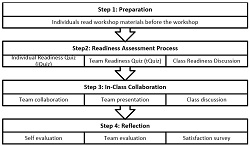Leveraging the Hawthorne Effect as a developmental tool in the classroom
Considering how researcher or instructor involvement can influence research outcomes by integrating the Hawthorne Effect, scaffolding, and situational leadership illuminates a potentially powerful instructional practice for improving student learning outcomes. In short, as demonstrated in the analysis of the Hawthorne Studies, being unaware of the Hawthorne Effect can diminish potential outcomes and feign change. However, deliberately leveraging attention events to scaffold learners from dependency to mutual dependence and self-reliance can influence positive outcomes and generate lasting change for groups and individuals.
Instructors can apply the Hawthorne Effect as an intervention tool in a collaborative action research classroom using actions like the following:
- Aware. Be aware of how attention events serve as temporary extrinsic motivators.
- Engage. Intentionally engage students in developing and implementing the classroom for individual and mutual development.
- Leverage. Leverage the attention event to generate and foster perpetual feedback loops that encourage students to improve skills and apply new tools for increased performance.
- Reinforce. Promote intrinsic motivation by reinforcing desired behavior through attention events with developmental feedback.
- Scaffold. As the student demonstrates understanding, withdraw from the attention event, monitor performance to determine if behavior changes last, and identify other intervention opportunities.
- Enlist. Once a student demonstrates competence, enlist the student as a mentor for other students.




